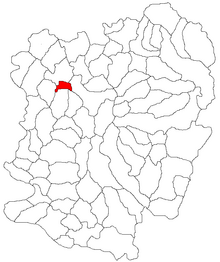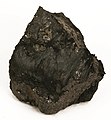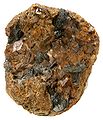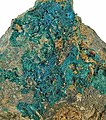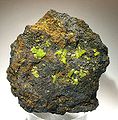Ocna de Fier
|
Ocna de Fier Eisenstein Vaskö |
||||
|
||||
| Basic data | ||||
|---|---|---|---|---|
| State : |
|
|||
| Historical region : | Banat | |||
| Circle : | Caraș-Severin | |||
| Coordinates : | 45 ° 20 ' N , 21 ° 47' E | |||
| Time zone : | EET ( UTC +2) | |||
| Area : | 22.11 km² | |||
| Residents : | 656 (October 20, 2011) | |||
| Population density : | 30 inhabitants per km² | |||
| Postal code : | 327290 | |||
| Telephone code : | (+40) 02 55 | |||
| License plate : | CS | |||
| Structure and administration (as of 2016) | ||||
| Community type : | local community | |||
| Structure : | Ocna de Fier | |||
| Mayor : | Panescu Petru Petrișor ( PNL ) | |||
| Postal address : | Str. Vale No. 107B loc. Ocna de Fier, jud. Caraș-Severin, RO-327290 |
|||
| Website : | ||||
Ocna de Fier ( German Eisenstein , Hungarian Vaskö ) is a municipality in the Caraș-Severin County , Banat , Romania .
Neighboring places
| Berzovia | Bocșa | Ezeriș |
| Fizeș |

|
Moniom |
| Doclin | Dognecea | Reșița |
Geographical location
Ocna de Fier is located in the Dognecea Mountains in the Banat Uplands on the DJ 586 Bocşa - Dognecea county road , 25 kilometers from the district capital Reşița and 100 kilometers from the city of Timişoara .
history
The oldest mining evidence comes from the Bronze Age around 4000 years ago, when natural copper was extracted here in open-cast mining . After the Romans conquered the area around 106, mining was also carried out underground . To the north of Ocna de Fier, on the gold hill (“Cracul cu aur”), old Roman gold mining facilities can still be seen today . The medieval gold mining was last mentioned in a document from the year 1552nd During the Ottoman rule (1554-1718) there was little interest in mineral resources and the area was sparsely populated. The discovery of rich iron ore deposits in the Morawitza Valley was only reported during the period of the Habsburg Monarchy after 1718 . Due to the rapidly increasing demand for labor, the mining settlement "Morawitzadorf" was founded in 1760 and mainly populated with Wallachian refugees, bufans, forest workers and miners from the area around Baia de Aramă . On the Josephine map of 1772 this settlement is entered as "Pogschaner Eisenstein".
The actual village "Eisenstein" was founded in 1815. At the same time, German skilled workers were also settled. In 1855 the Viennese court chamber sold the Eisensteiner iron mines with the Banat mining area to the Austro-Hungarian State Railway Company (StEG). In 1919 the entire Banat mountain region fell to Romania. This transformed the StEG into a Romanian joint-stock company "Uzinele de Fier și Domeniile din Reșița" (UDR).
After the Austro-Hungarian Compromise (1867), the Banat was annexed to the Kingdom of Hungary within the dual monarchy of Austria-Hungary .
At the beginning of the 20th century the law for the Magyarization of place names (Ga. 4/1898) was implemented. The official place name was Vaskö . The Hungarian place names remained valid in the Kingdom of Romania until the administrative reform of 1923 when the Romanian place names were introduced.
The Treaty of Trianon on June 4, 1920 resulted in the triple division of the Banat , whereby Ocna de Fier fell to the Kingdom of Romania .
Mining
As a result of a study trip through the Banat mountains, Bernhard von Cotta wrote his reference work in 1864 and named the texture of the igneous rocks "Banatite". In 1874 the mining engineer "Anton Veszelyi" (1820–1888) delivered Eisensteiner ore samples in which the Viennese professor Gustav Tschermak discovered the previously unknown mineral Ludwigite and Albrecht Schrauf discovered the mineral Veszelyite in 1874 .
In 1972 the geologist Gruescu discovered several cruciform quartz crystals in the “Reichenstein” iron mine , novel crystallization forms that were named after the discoverer, the “Gruescu coaxial twins”.
After 1990 there was no more active mining, between 1992 and 1997 only the material from the old dumps was used. This mining activity has also been permanently discontinued since 2001. In total, an estimated 11 million tons of iron and 3 million tons of non-ferrous metals have been extracted from Eisensteiner ores over time.
Museum of Aesthetic Mineralogy of Iron
The collector Constantin Gruescu founded an extremely valuable mineralogy collection in his house in Ocna de Fier , where special minerals can be observed. Some are unique in the world. The private "Museum of the Aesthetic Mineralogy of Iron" ( Romanian Muzeul de mineralogie estetică al fierului ) houses various rare minerals ( andradite , ludwigite) and rocks ( dognácskaite , warthaite ). At the end of the 20th century Gruescu presented his mineralogy collection and donated some copies to Romanian and foreign private individuals and public institutions. Teachers and specialists, students and prominent personalities, tourists and visitors from all over the world admired the collection of more than 2,000 pieces. Its most prominent visitor was the Dutch Queen Beatrix .
Picture gallery
Rare minerals from the Ocna de Fier mining area, exhibited in the Museum of Aesthetic Mineralogy of Iron :
tourism
Due to the beautiful landscape, Eisenstein has gradually developed into a tourist magnet. More and more strangers bought houses here and converted them into holiday homes. The karst landscape with numerous valleys, gorges and caves is especially attractive for sport climbers . Around 17 caves and the largest vertical stone wall in the Banat (116 meters) can be found here. Old spoil heaps and opencast mines offer the hobby mineralogists numerous finds. The "Goldhügel" area with its as yet unexplored Roman gallery system is ideal for mining archaeologists. The highlight of every tour is a visit to the Museum of the Aesthetic Mineralogy of Iron.
Demographics
Ocna de Fier had the largest population in the 1960s. Since then, the population has been falling steadily. The village is gradually turning into a holiday and leisure place.
| census | Ethnicity | |||||||
|---|---|---|---|---|---|---|---|---|
| year | Residents | Romanians | Hungary | German | Other | |||
| 1880 | 1012 | 919 | 10 | 78 | 5 | |||
| 1910 | 1332 | 1174 | 33 | 120 | 5 | |||
| 1966 | 1853 | 1716 | 44 | 38 | 55 | |||
| 1977 | 1422 | 1328 | 29 | 33 | 32 | |||
| 1992 | 907 | 855 | 7th | 21st | 24 | |||
| 2002 | 792 | 769 | 5 | 10 | 8th | |||
Personalities
Personalities who have made a name for themselves through their work in and around Ocna de Fier:
- Georg Pokrean, mining officer of the StEG and member of the Hungarian Geological Society (1886)
- Alexander Kissling, non-fiction author on Eisenstein mining (1967)
- Constantin Gruescu (born 1924), mining technician and mineral collector, member of the Romanian Society for Geographical Sciences
Town twinning
- A partnership with the Alsatian municipality of Osenbach has existed since 1997 .
literature
- Ignaz von Born : Letters about mineralogical objects , letter 9. Frankfurt, 1774.
- Edmund Schelken: The minerals of Dognecea and Ocna de Fier in Romania. Lapis-Magazin, Munich 1993
- Carol Brandza: Contribuții la cunoaşterea minelor vechi aurifere din zona Bocşa-Ocna de Fier-Dognecea. Banatica, Reșița 1986.
Web links
- The Constantin Gruescu Museum in Ocna de Fier (Romanian)
- The Constantin Gruescu Museum at thematicroutes.dkmt.eu/de
- ghidulprimariilor.ro , Ocna de Fier
Individual evidence
- ↑ 2011 census in Romania ( MS Excel ; 1.3 MB)
- ↑ Mayoral elections 2016 in Romania ( MS Excel ; 256 kB)
- ↑ a b c banater-berglanddeutsche.de ( Memento from January 29, 2013 in the Internet Archive ), Eisenstein
- ↑ banater-aktualitaet.de , Dognatschka and Eisenstein
- ^ Gerhard Seewann : History of the Germans in Hungary , Volume 2 1860 to 2006, Herder Institute, Marburg 2012
- ↑ G. Tschermak: Ludwigite, a new mineral from the Banate . In: Mineralogical communications . tape 1 , 1874, p. 59–66 ( rruff.info [PDF; 418 kB ; accessed on January 9, 2018]).
- ↑ A. Schrauf: Investigation of a new mineral, called Veszelyit . In: Gazette of the Imperial Academy of Sciences . tape 11 , 1874, p. 135–137 ( rruff.info [PDF; 245 kB ; accessed on January 9, 2018]).
- ↑ Mindat - Dognácskaite
- ↑ Mindat - Warthite
- ↑ thematicroutes.dkmt.eu , Museum of Aesthetic Mineralogy
- ↑ banatulmontan.wordpress.com , Constantin Gruescu şi Muzeul de Mineralogie Estetică a Fierului
- ↑ kia.hu (PDF; 858 kB), E. Varga: Statistics of the number of inhabitants by ethnicity in the Caraș-Severin district according to censuses from 1880 - 2002
- ↑ constantingruescu.ro ( Memento from September 29, 2010 in the Internet Archive ), Constantin Gruescu
- ↑ amitie-franco-roumaine.com ( Memento of February 9, 2011 in the Internet Archive ), town twinning


